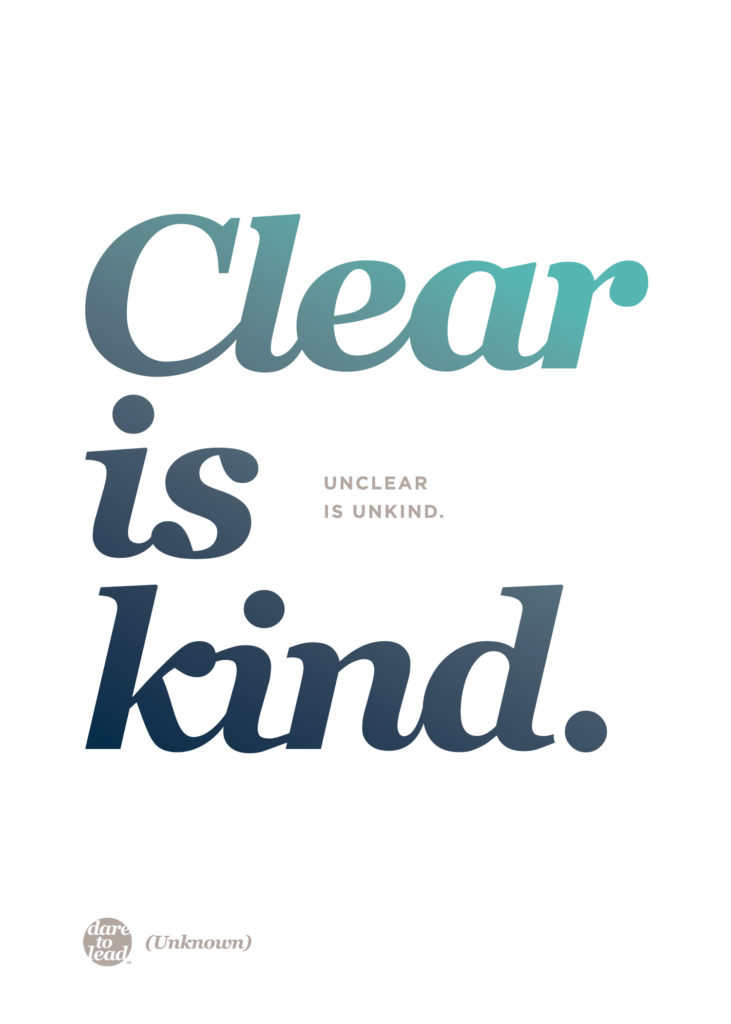It’s been over a year of navigating the unknowns of virtual and hybrid work. Businesses have made significant pivots and we’ve all been forced to be flexible and learn on the fly as we deal with the avalanche of constant change.
We can’t deny the impact that this extra layer of stress & overwhelm has had on our workplaces. Whether you’re working virtually, in person, or somewhere in between, the pandemic has taken a toll on how we work and communicate, causing employees to feel a lack of trust and belonging.

That’s why boundaries are so important for any team as they navigate today’s workplace, especially around communication.
Here are 3 ways to set boundaries to help build trust within your team.

1. Be Clear.
Let’s start with the concept of ‘Clear is Kind, Unclear is Unkind.’
Here’s a snippet from Brené Brown around this concept:
“Sometimes speaking the truth feels like we are being unkind, especially when sharing difficult information or feedback. But in reality, dancing around the truth is unkind.
When we avoid stating the truth, when we are vague or ambiguous under the guise of being kind, it is often because we are trying to lessen the discomfort for ourselves, not for the other person.”
Contrary to what many of us have been told, “if you have nothing nice to say, then don’t say anything at all.” But that mentality doesn’t help teams innovate and provide world-class service. It stalls a team and stunts its growth.
Instead, be clear about what you need. This allows a team to work through challenges instead of avoiding them and walking around on eggshells around each other. It gives other people the opportunity to change their behavior so that future obstacles can be avoided.
If you aren’t clear, the people around you may not know anything is wrong and won’t change their behavior. This will only cause the problem to grow. You assume they ‘should know better’ and it’s their fault for not reading your mind. In reality, it is your responsibility to be clear – not for them to be mind readers.
If you catch yourself using the excuse “I don’t want to hurt their feelings” to avoid a tough conversation, challenge yourself to lean into being kind by being clear. It will likely be uncomfortable at first, but the more you practice, the easier it will be. And it will pay off in the long run. Your team will begin to build trust when they realize there is a culture of openness and honesty.
2. Define what’s okay, what’s not okay, and why.
Now that we’ve set a culture of clear and open communication, we can set more boundaries around what is and is not okay. This helps everyone stay on the same page.
By setting boundaries, we’re making it super clear what is okay, what’s not okay, and why. These expectations should be clear and communicated to everyone.
These definitions start with leadership. Leaders are responsible for setting the tone of what flies and what does not in the workplace. When leaders not only talk the talk but walk the walk, the rest of the team will follow.
Empowering everyone with a common language on how to communicate when someone is not acting in alignment with the agreed-to boundaries is another important step in this process.
Giving a team clear guidelines, but also the tools they need to navigate when someone does do something that is not okay can be truly transformational.
3. Create A Communication User Guide
Now that we’ve been clear and defined what’s okay and what’s not okay, it’s time to document it.
‘If everyone knows what’s expected, then why do we need to write it down?’
No team is perfect. Even with clear boundaries and trusting relations, conflict and miscommunications will happen. And when they do, it’s best to have a clear set of documented standards to go back to. This will keep the situation objective and yes, clear.
This will also help new team members navigate the company culture. Instead of everyone following the unwritten rules of the office, they will have clearly defined, written policies and procedures to return to. This saves time and takes out the guesswork. It lets everyone know what’s expected instead of assuming everyone is on the same page. 
In a communication user guide, leaders can summarize their:
- Communication style and how to best communicate with
- Response time expectations and email etiquette
- Hierarchy of communication from urgent to FYI
- Reporting chain
- Instructions on how to best approach them for feedback
Boundaries Build Trust
By clearly communicating what’s okay, what’s not okay, and why, you’ll make it easy for everyone to understand and respect workplace boundaries. Remember – CLEAR IS KIND! Be kind to your team by being clear about what is expected of them and how they can best communicate with you and each other.
For those of us who love learning about communication styles, workplace culture, and self-development, this stuff may sound like a no-brainer. But not everyone is like us!
That’s why it’s even more important to set clear boundaries and expectations on what we need in the workplace. Everyone is different. Everyone has different comfort levels and communication styles.
This will help your team avoid unnecessary conflict and miscommunications while saving everyone time and energy. What company doesn’t want that?
If your team is struggling with communication, let’s chat! We’d love to talk through your team’s unique strengths and challenges to find where you can build more trust through boundary setting and communication.




